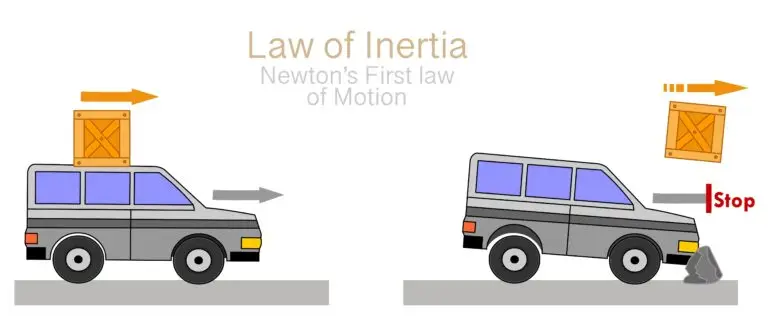Inertia

Table of Contents
What is Inertia?
Inertia refers to an object’s natural tendency to resist changes in its motion or state of rest. Essentially, it’s the property that keeps an object still if it’s at rest or keeps it moving in a straight line at a constant speed if it’s in motion unless a force acts on it to cause a change. This resistance to change in motion is a fundamental aspect of an object’s behavior.
The principle of inertia is foundational to Newton’s first law of motion, often called the law of inertia. This law posits that an object will not change its motion unless a net external force is applied. For example, a ball rolling on the ground will eventually stop due to external forces like friction and air resistance, not because of its inertia. In the absence of these forces, such as in the vacuum of space, the ball would continue to roll indefinitely in a straight line at a constant speed.
Types of Inertia
Mass Inertia
Mass inertia is a concept that links an object’s mass to its inertia, indicating that an object’s resistance to changes in its motion is directly related to its mass. Essentially, the more mass an object has, the greater its inertia, meaning it will resist changes in its state of motion more strongly than an object with less mass.
For instance, a heavy truck has more mass and therefore more inertia than a bicycle. As a result, a significantly larger force is required to bring the truck to the same acceleration or deceleration as the bicycle. It explains why heavier objects are harder to start moving, stop, or change direction, shaping our strategies for managing and applying forces in the real world.
Directional Inertia
Directional inertia refers to an object’s tendency to maintain its state of motion and its direction of travel. This means that a moving object will keep moving along the same straight path unless a force acts upon it to alter that trajectory. The direction in which an object moves is as resistant to change as the motion itself due to inertia.
This aspect of inertia is crucial in space travel. In the vacuum of space, where there is little to no external force like air resistance or friction to affect movement, a spacecraft will continue in the direction it is moving unless acted upon by a force, such as thrust from its engines or gravitational pull from celestial bodies.
This property allows spacecraft to travel long distances in space with minimal fuel consumption once they have achieved the desired velocity and direction. Engineers and scientists must carefully calculate the forces needed to start, steer, and stop spacecraft, taking into account the directional inertia to ensure that these vehicles follow the intended paths through space.
Effects of Inertia
Uniform Motion
Uniform motion refers to an object moving at a constant velocity, meaning it has a steady speed and direction. Inertia allows objects in uniform motion to continue their motion indefinitely, assuming no external forces act on them. This state of motion is a direct demonstration of inertia, highlighting its role in maintaining the constancy of motion.
A practical example is a ball rolling on a perfectly frictionless surface. Without friction or other external forces to slow it down, the ball would keep rolling at the same speed and in the same direction forever. Similarly, a satellite in space, once placed in a stable orbit around Earth, will continue to follow that trajectory due to its inertia. The gravitational force provides the necessary centripetal force to keep the satellite in orbit but doesn’t slow it down; instead, it keeps changing the direction of the satellite’s velocity, maintaining its uniform motion around the Earth.
Resistance to Acceleration
Inertia is the property that causes objects to resist changes in their velocity, which includes changes in both speed and direction, often referred to as acceleration. When a force is applied to an object to change its motion, its inertia resists this change. This resistance is why we feel certain effects when accelerating or decelerating quickly.
Take a car as an example: when it accelerates forward, the passengers inside feel a force pushing them backward. This is not because a literal force is pulling them back but because their bodies want to stay in their previous state of rest or uniform motion due to inertia. The car’s seat or seatbelt provides the force necessary to overcome this inertia, bringing the passengers’ bodies up to speed with the car.
Applications of Inertia
- Transportation: Understanding inertia is crucial in vehicle design and operation. Inertia affects how vehicles accelerate, decelerate, turn, and maintain stability on various terrains.
- Sports and Recreation: Inertia is relevant in sports and recreational activities. For example, the inertia of a ball in motion determines how it responds to being kicked, thrown, or struck.
- Astronomy and Space Exploration: Inertia is a fundamental consideration in the motion of celestial bodies, spacecraft trajectories, and the behavior of objects in microgravity environments.
Inertia and Newton's Laws of Motion
- Newton’s first law of motion, which introduces the concept of inertia, is the foundation of classical mechanics. It states that an object will remain at rest or in uniform motion unless acted upon by a net external force.
- Inertia is also related to Newton’s second law (F = ma), which describes how forces cause changes in the motion of objects based on their mass and acceleration. The resistance to changes in motion due to inertia influences how forces affect objects.
Related Links
Acceleration
Centripetal Force
Friction
Mass